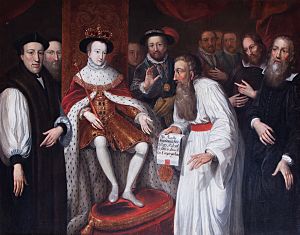Jan Łaski facts for kids
Jan Łaski (pronounced 'Yan Wash-kee'), also known as Johannes à Lasco, was an important Polish religious leader. He lived from 1499 to 1560. He was a key figure in the Calvinist movement, which was a branch of Protestantism. Because of his important work in England between 1548 and 1553, he is often called John à Lasco in English-speaking countries.
Contents
Jan Łaski's Early Life
Jan Łaski was born in 1499. His father, Jarosław Łaski, was a powerful official called a voivode in the region of Sieradz. While some historians thought he was born in the family's castle in Łask, we don't know the exact place for sure.
His uncle, who was also named Jan Łaski, was a very important church leader. He was the Archbishop of Gniezno, the main church leader in Poland, and a top government official. This uncle helped Jan Łaski start his career. The Łaski family used a special symbol called the Korab as their family crest.
Religious Journey and Influence
After his family lost some of its political power, Jan Łaski, who was a well-educated priest, traveled to Basel in 1523. There, he became good friends with famous thinkers like Erasmus and Zwingli.
In 1542, he became a pastor at a Protestant church in Emden, which is in Germany. Soon after, he moved to England. In 1550, he became the leader of the Strangers' Church of London. This church was for European Protestants who had moved to England. He had some influence on church matters during the rule of King Edward VI.
When the Catholic Queen Mary came to power in July 1553, Jan Łaski had to leave England. He sailed to Copenhagen with many refugees from the Strangers' Church. However, they were not allowed to stay there because they did not agree with a specific religious statement called the Augsburg Confession. They eventually found a new home in Brandenburg. Łaski also helped Catherine Willoughby and her husband after they left England. His support helped them get a job from King Sigismund II to manage Lithuania.
Jan Łaski also exchanged letters with John Hooper. He supported Hooper in a debate about what church leaders should wear.
Return to Poland
In 1556, Jan Łaski was asked to return to Poland. There, he became a secretary to King Sigismund II. He also became a leading figure in the Calvinist movement in Poland.
He helped shape the way Calvinist churches were run. He believed there should be no real difference between ministers and elders, except for who could teach and perform religious ceremonies. In 1544, he met with an Anabaptist leader named Menno Simons. After this meeting, Łaski created the term "Mennonites" for Simons' followers.
Jan Łaski passed away in Pińczów, Poland.
Key Writings
- Forma ac ratio (1550) -- This was a guide for how the churches for foreigners in London should conduct their services. It might have influenced other important religious texts, like the 1552 Book of Common Prayer in England.
See also
- Jan Łaski (1456–1531)
- Andrzej Frycz Modrzewski
- Wacław of Szamotuły
- List of Poles
Images for kids




